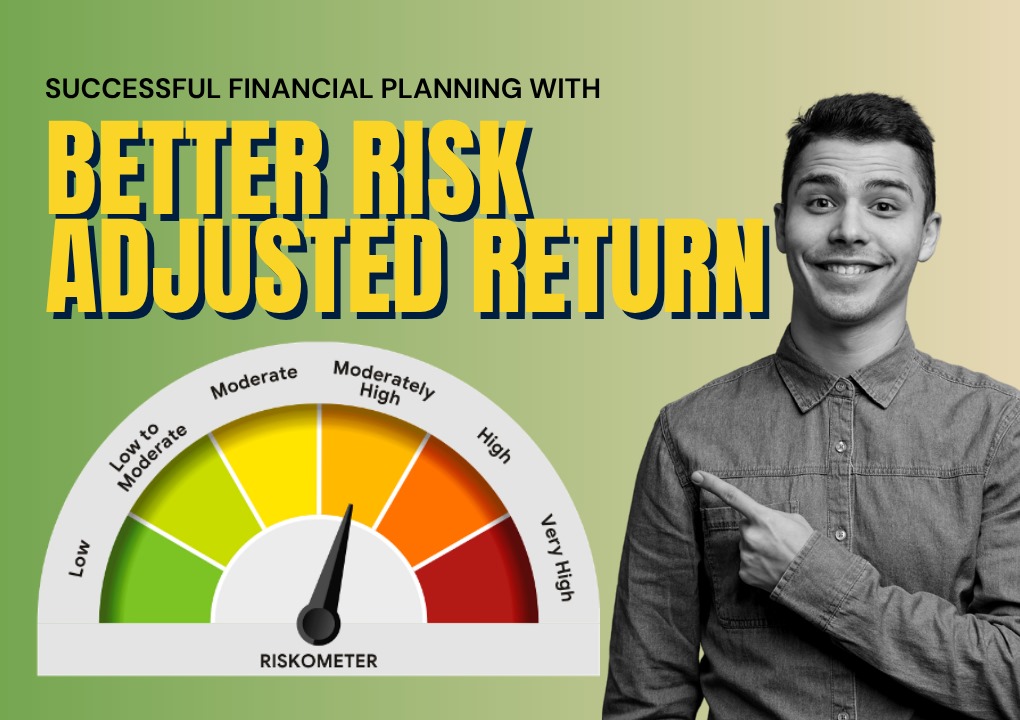TL; DR:
The article emphasizes the importance of focusing on financial goals rather than chasing market returns blindly. It introduces the concept of risk-adjusted returns, which evaluate returns relative to the risk (variability of returns) taken over a period matching the investment goal. The Sharpe ratio is often cited as a standard metric for measuring this risk-return balance.
Using the Nifty 50 index as an example, the article shows that long-term investments in equities can deliver strong returns with moderate to high volatility. A clear framework involving goal-setting, planning, and execution is presented to align investment portfolios with one’s financial objectives. The article emphasizes that relying solely on raw returns is insufficient; instead, optimizing risk-adjusted returns increases the likelihood of meeting financial goals successfully.
We may have all come across a series of articles on the internet, YouTube videos, and podcasts where experts talk about the rules of disciplined investing. All these expert articles emphasize that financial goals should take precedence over market returns when making investment decisions. But the day we see markets jumping upwards randomly, we forget this fundamental rule. Greed often takes precedence over financial goals, and that is where we usually end up making mistakes. We jump onto the bandwagon of buying frenzies and try to catch the fastest running horse in the game. It leads to numerous poor decisions, and you may even miss the deadline for reaching the goal.
Then the question might arise: whether chasing returns is not the solution; so, what is the right strategy?
Understanding risk-adjusted returns
Instead of following the herd mentality of jumping into a bullish market for any asset class (equity, debt, gold, silver, etc.), it is always better to examine the risk-adjusted return for the asset class over the period that matches the term of your financial goal.
Let’s try to understand the meaning of risk-adjusted return. It is the measure that evaluates the return of the asset class relative to the risk taken.
How is risk defined?
Financial experts define risk associated with investing in any asset class by the variability of returns for a specific period, when measured across multiple periods in history. For example, if we examine the yearly returns of the Equity markets over the last ten years, one would find a range of negative & positive returns that revolves around the average annual return. From an investing standpoint, this variation in returns around the average return is called the risk. The. The higher the variation in returns, the higher the risk associated with the asset for the term of the investment. This particular definition of risk gives you a probability of loss of capital ( as a layman’s definition of risk) for a specific term of investment, which matches your goal term.
Sharpe ratio: A standard metric to measure risk-adjusted return
Probably, if you check a factsheet of any mutual fund scheme, you might have come across the term Sharpe ratio. William Sharpe, a well-known American Economist of the 1960s, developed the Sharpe ratio measurement. In layperson’s terms, the Sharpe ratio measures the “Return per unit of risk”.
When comparing mutual fund schemes within the same category, experts suggest that the scheme with a high Sharpe ratio is generally a better option. However, there are additional metrics to make that judgment.
The risk-reward profile of the most popular asset: Equity
Let’s examine the risk-reward profile for the Nifty 50, a popular stock market index comprising the top 50 stocks listed on the National Stock Exchange. The Nifty 50 index has been effective since November 3, 1995. Over a period of 25+ years until the end of 2021, the Nifty 50 Total Return (TR) index has delivered the following risk-reward profile:
- The index yielded annualized returns of approximately 14.2% CAGR, with an annualized volatility of around 22.9%. It includes dividends reinvested, reflecting total returns.
- Rolling return analysis shows that for investment horizons of 7 to 10 years and longer, the Nifty 50 TR index returned more than 15% p.a. nearly 40-48% of the time, and the frequency of positive returns approached 100% for horizons beyond 7 years.
In summary, since its inception over 25 years ago, the Nifty 50 has delivered strong, consistent risk-adjusted returns with moderate to high volatility, making it an effective benchmark for long-term equity investment in India.
Why is understanding risk-reward crucial for goal achievement?
It is essential to understand the risk-reward associated with an asset or a combination of assets into which one needs to deploy their savings to achieve any financial goal. Any misadventure can lead to shortcomings in attaining one’s goals.
To understand why this is important, one needs to comprehend the entire process of goal setting, financial planning, and execution.
Step 1: The first step is goal-setting, which involves defining the future value of the goal and its term, or the inflation-adjusted value of the goal on a specified future date.
Step 2: The second step is goal planning. The value one wants to achieve will not come by magic; one definitely needs to commit to a certain amount of savings. The savings may not represent the total future value, but rather a portion of it; one must generate the remainder by investing the savings in the right combination of assets or a well-diversified portfolio.
Step 3: The third step is goal execution, which involves selecting the right financial products that mirror the asset portfolio.
Now that you are clear on the total process, it is essential to understand that you cannot do goal planning by just looking at the raw return data of the portfolio or an asset. Every asset offers a different risk-return profile for different investment terms. Since your goal has also been defined explicitly in terms of investment, it is essential to have an investment portfolio that offers a better return for a unit of risk for that term.
So we can conclude that irrespective of the asset class or a combination of asset classes, one chooses to achieve their financial goals, one can’t bluntly rely on the raw return data ( remember past return is not always the reflection of future returns ) so it better construct a portfolio strategy that gives the optimum risk return to ensure higher probability of success in achieving financial goals.






